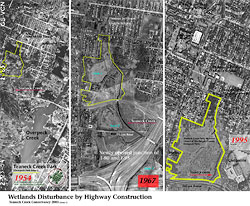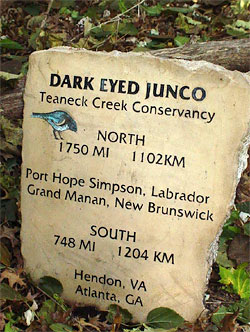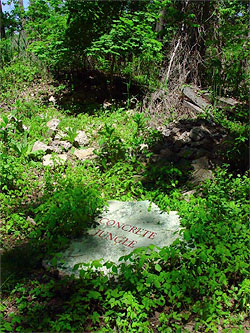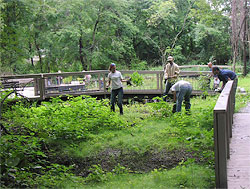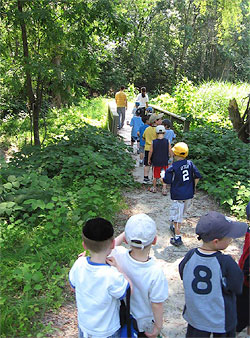A Historical Perspective on the Urban Wetlands of the Teaneck Creek Conservancy
by Mary Arnold
Teaneck Creek Conservancy, Inc., 20 Puffin Way, Teaneck, New Jersey 07666
Abstract
The wetlands of northeastern New Jersey, formed after the Wisconsin glacier retreated approximately 10,000 years ago, have undergone extensive damage by humans since their formation. Projects undertaken to support the increasing urbanization of Bergen County, including interstate highway construction during the 20th century, caused particularly severe damage to the wetlands, and today, remaining Teaneck Creek wetlands are situated in a watershed whose land use is 95% urban. The 46-acre Teaneck Creek Conservancy site, owned by Bergen County, New Jersey, as an area within Overpeck Park, is managed by the Teaneck Creek Conservancy. Today, these wetlands serve as a stormwater retention basin for the Teaneck Creek watershed. The Conservancy aims to protect the site's least-disturbed wetlands and to reestablish 20 acres of forested riparian wetlands by reconnecting Teaneck Creek with the site's interior surface and ground waters, removing fill materials, eliminating and controlling invasive plant species, and planting native vegetation. The project is an interdisciplinary collaboration between the Teaneck Creek Conservancy, Bergen County, and Rutgers University.
Keywords: Urban restoration, urban wetland, urbanization, urban habitat, urban ecosystem, Bergen County
Introduction
During the 19th and 20th centuries, industry, transportation, population growth, and various cultural lifestyles in northeastern New Jersey set in motion accelerating changes to local ecosystems. Historically, the lands and waters of Teaneck Creek, in what is now Teaneck, New Jersey, have been utilized in multiple ways—several hundred years ago as Lenape Indian homeland and Colonial farmland, in the twentieth century as a site for transportation development and dumping (Taylor 1977), and today as public parkland. The Teaneck Creek Conservancy wetland baseline characterization highlighted in this volume will support the reestablishment of 20 acres of riparian forested wetlands on this 46-acre urban site. The project's approach to wetlands restoration is based on local ecology, interdisciplinary wetlands science, and an iterative approach to site investigation, research, and restoration planning. This approach acknowledges the need for in-depth understanding of the anthropogenically influenced site conditions. The project also recognizes the need for participation by local communities and government agencies in the reclamation, enhancement, and protection of urban natural resources.
The Conservancy was started after surveyors' flags were observed on the property and community leaders in Teaneck, New Jersey, decided to protect the land from development. When they discovered that Bergen County owned the land, these community advocates conceived a plan to transform the tract into a publicly accessible park. The nonprofit Conservancy was incorporated in 2001, and over an 18-month period it led a series of 17 community meetings to engage community residents and elected officials in its cause. The overall goal of the project that the Conservancy proposed to Bergen County was creation of a park that would use art and landscape design to integrate the natural, historical, and cultural history of the area. Two specific project goals were restoration and enhancement of the site's degraded wetland areas and reintroduction of native plant species (TCC 2001). In 2002, the Conservancy negotiated a long-term lease with Bergen County to develop and manage the 46-acre site for the purposes of public recreation, outdoor education, cultural programming, and enhancement of existing natural resources (TCC 2002). In 2004, the Bergen County Freeholders passed a resolution authorizing a memorandum of understanding among the County, the Conservancy, and Rutgers University to support the study, restoration, and protection of the Conservancy wetlands (MOU 2005).
Historical Perspective
Click image to enlarge
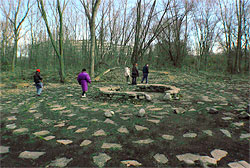
Figure 2: The Turtle Peace Labyrinth was constructed from concrete debris found on-site at the Teaneck Creek Conservancy. To create the labyrinth pathway, volunteers relocated the pieces of rubble by hand from their original location on the banks of the creek to the site of a former ball field (photo courtesy of Richard K. Mills).
The story of the decline and reclamation of Teaneck Creek's wetlands begins in the 1600s, when Lenape Indian leader Sachem Oratam deeded more than 2,000 acres to Dutch colonist Sarah Kiersted. The English Governor Philip Carteret granted a "patent" to Sarah Kiersted, a deed confirming her ownership of land that included the current Conservancy site. At the time Oratam deeded the property to Kiersted, a diverse ecosystem existed there with a wealth of water resources, including, according to the words of the English deed, "woods, pastures, fields, Meadows, Pools, Ponds, Islands, Creeks, Marshes, River." The water-rich ecosystem contained tributaries to the Hackensack River and provided habitat that the deed describes as conducive to "Hawking, Hunting fowling, fishing." These natural resources provided food for the Colonists and are characterized in the deed as part of the "Gaines and Proffits" of Oratam's gift to Kiersted. By the time the Conservancy was incorporated, 335 years after Oratam gave away this land, the property had been a dump site and degraded wetland for half a century, surrounded by "keep out" signs.
Teaneck Creek's wetlands declined during the late 19th- and 20th-century periods of industrialization, urbanization, and the resultant draining and filling of marshlands. Draining for Profit and Draining for Health (Waring 1879) sums up the then common perception of wetlands as wasteland. Waring described the New Jersey Meadowlands, of which the wetlands of Teaneck Creek are a historic remnant, as "pest" lands that offered huge financial potential if drained for development. "A single tract, over 20,000 acres in extent, the center of which is not seven miles from the heart of New York City, skirts the Hackensack River, serving as a barrier to intercourse between the town and the country…constituting a nuisance and an eyesore…. Virgin lands, replete with every element of fertility, capable of producing enough food for the support of millions of human being…all allowed to remain worse than useless…. The inherent wealth of the land is locked up, and all of its bad effects are produced, by the water with which it is constantly soaked or overflowed." Bergen County's Preliminary Assessment Report (PAR 2006) to the New Jersey Department of Environmental Protection Division of Responsible Party Site Remediation describes the site's previous land uses. The Sanborn Map (1926 through 1957) shows that parts of the site were used by a laundry, a construction company, a dance hall, and residences, among other uses. From 1899 until 1938, a trolley line ran through the site.
In the early 1950s, Bergen County developed a plan for the wetlands of Teaneck and Overpeck Creeks which proposed filling the wetlands with municipal waste and clean dredge, and then redeveloping the area as a 1,000-acre park. The Township of Teaneck transferred property for the creation of the public park and recreation area (Deed 1951). Overpeck Creek was widened and deepened through dredging, and tidal gates were constructed in the vicinity of the New Jersey Turnpike Overpass. Land elevations surrounding the creeks were raised above the water level by placement of sanitary waste and material dredged from Overpeck Creek. These fill activities resulted in the berming of Teaneck Creek, and the downstream tidegate caused the creek to be cut off from the tidal flow of the Hackensack River.
When the Conservancy acreage was originally transferred to Bergen County, the environmental issue concerning the Township of Teaneck was that they be allowed to continue to use the property as a waste dump and stormwater sump. The transfer deed includes the following provisions: (a) the right to use any or all of the premises for the disposal of garbage, ashes, refuse, and fill through any agency, contractor, or licensee engaged to remove such material for the Township of Teaneck now and in the future; (b) the right to continue the operation, maintenance, and enlargement of all existing disposal plants, sewage pumping stations, sanitary and storm drains, and rights of way, and to increase or provide new facilities as it may deem advisable; (c) the same rights and privileges were granted to the Bergen County Sewer Authorities (Deed 1951). After the land transfer, the 46 acres became known as "Area 1" of Overpeck Park. Although the wetlands of Teaneck Creek were not used for disposal of municipal waste, Area 1 experienced further degradation from dumping and filling by both private companies and the N.J. Department of Transportation, which used the site in the 1960s as a staging and disposal area for dredge and construction debris materials while building the New Jersey Turnpike and Interstate 80 (Figure 1).
Natural and manmade fill materials were deposited mainly on the southern and eastern sides of the Conservancy site (PAR 2006). Materials deposited on the site in the 1960s consisted primarily of domestic waste, including cans, bottles, clothing, and plastic, while the surficial debris included brick, glass, concrete, roofing materials, lumber, automotive parts, and appliances. An existing Area of Concern (PAR 2006) is groundwater contamination from benzene, tert-butyl alcohol, and methyl-tertiary-butyl-ether (MTBE) that leaked from underground gas station storage tanks on adjacent properties located along the western edge of the Conservancy site. The NJDEP has ongoing oversight of the groundwater contamination, which is currently being remediated.
Since the Conservancy began in 2001, volunteers have removed multiple Dumpster loads of debris, including automotive parts, construction materials, and discarded household appliances, from the site using only hand tools. The remaining fill is too heavy to lift or is located in inaccessible areas. Some concrete debris has been recycled into artworks by artist Ariane Burgess, who led volunteers in the creation of a Peace Labyrinth built from blocks of concrete found on site (Figure 2), and artist Lynne Hull, who created concrete "Migration Mileposts" (Figure 3) that celebrate the birds (documented by DNA or radio telemetry) that pass through the site when migrating along the Atlantic Flyway. Teaneck artist Richard K. Mills's "Concrete Jungle" lies among other huge slabs of concrete roadway next to Dragonfly Pond, an open water area (Figure 4).
Teaneck Creek Conservancy Today
Today the Conservancy's 46 acres are virtually the only undeveloped land in the Teaneck Creek watershed. In this highly urbanized area, the creek is a component of the receiving waters for the Township of Teaneck municipal stormwater system, serving as the discharge point for six stormwater outfalls that drain directly into Teaneck Creek and its wetlands. The channelization, downcutting, and berming of the creek and the clay dredge and debris that fill and compact the site all impede groundwater and creek connectivity. Today, precipitation and stormwater are the primary hydrologic inputs for the site's wetlands. In addition to the stormwater inputs, we discovered that a local hospital is permitted to pump 100,000 gallons of groundwater per day into Teaneck Creek in order to keep the hospital basement dry (W. Kinder personal communication). The banks of Teaneck Creek are cut and filled, eroded, and sometimes blown out during storms. The resulting siltation, as well as nonpoint source and thermal pollution that result from drainage from the hospital's sterilization facility, degrade the water quality in the creek.
Benthic studies (Serra 2001) revealed "poor" water quality, which supported only pollution-tolerant taxa identified as aquatic worms, black fly larvae, midge larvae, pouch, and other snails. Nonetheless, with its unique freshwater wetland system, Teaneck Creek does support other aquatic life, including killifish (Fundulus spp.), green frogs (Rana clamitans), bullfrogs (Rana catesbeiana), snapping turtles (Chelydra serpentina), and eastern box turtles (Terrapene carolina carolina), which have all been observed on site. Wildlife observation is a popular activity at the Conservancy. Bird species observed by scientists, volunteers, and visitors between 2003 and 2007 (Table 1) include Great Blue Heron (Ardea herodias), Green Heron (Butorides virescens), and Great Egret (Ardea alba). Mammal species observed include red fox (Vulpes vulpes) and white-tailed deer (Odocoileus virginianus). Rutgers scientists and engineers anticipate that stormwater retrofits and planned wetland and creek enhancements will improve water quality, biodiversity, and wildlife habitat at the site. Natural restorative processes are also playing a positive role in the Conservancy's rehabilitation. Native trees (e.g., Acer rubrum), shrubs (e.g., Viburnum dentatum), and herbaceous plants spontaneously grew from the seed bank when the burden of debris and invasive vegetation was removed from the wetlands by volunteers and by the contractor constructing our trail system.
During a field visit in 2004, Dr. Steven Handel noted an area on the northeastern edge of the site containing seeps, vernal pools, and native plant species that were characteristic of New Jersey riparian corridors of 350 years ago. Even in more degraded areas of the property, Dr. Handel observed remnants of native vegetation that would have been familiar to the Dutch colonists. Dr. Handel advised that these wetland fragments containing native vegetation be guarded from invasive plants through selective weeding, and that the northeastern section become the reference for restoration of the site. A specific example of the influence of scientists on all aspects of the project occurred when community leaders planned to build the Puffin Outdoor Classroom within the wetland remnant Dr. Handel suggested be the reference for the Conservancy's restoration. The original concept was to locate a classroom in this area to enable schoolchildren to appreciate the natural beauty and diversity of riparian wetlands. The non-scientists ultimately were persuaded that they were going to destroy what they treasured—the highest quality natural resources on the property. We redesigned the classroom and relocated it to an adjacent area that already was highly disturbed and covered by Phragmites. Invasive vegetation was removed, native wetland vegetation and seeds were planted, and additional native vegetation grew from the seed bank. The classroom that opened to the public in May 2006 overlooks the native vegetation of the remnant wetland (Figure 5). The restored wetland acreage in the outdoor classroom has met one of the wetland restoration and enhancement project deliverables funded through the N.J. Wetlands Mitigation Council grant supporting this project.
As degraded as this place was when the Conservancy was founded, as difficult as the work has been at many points, citizens have reclaimed and, with the help of scientists, are transforming the lands and waters of Teaneck Creek from a dump in to a unique wetland restoration and a renewed civic space (Figure 6).
Acknowledgments
We gratefully acknowledge the scientific support provided by faculty, staff, and students of Rutgers University, U.S. Geological Servey, and TRC Omni Environmental. Funding support for the Teaneck Creek Conservancy has been provided by the Puffin Foundation and the Rosenstein family. Funding for the site characterization and restoration/enhancement of 20 wetland acres has been provided by the New Jersey Wetland Mitigation Council. We thank Dr. Marion McClary, P. Warny, and B. Ballengee for identification of benthic invertebrate species and Dr. Peter Kallin and Richard Engsberg for identification of avian species.

